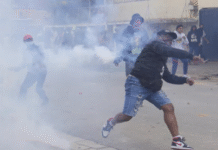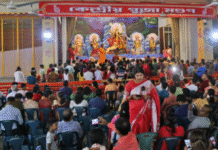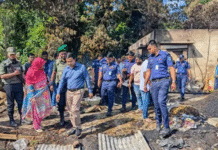
Elected lawmaker of Dhaka-7 three times since 1996, he has over the years either had a hand in the destruction of heritage sites and antiquities in his constituency or never showed political support to heritage conservation.
There is no exact count of how many heritage sites were destroyed over the last few years, but Dhaka-6 and Dhaka-7 contain hundreds of structures that can legally be termed antiquities.
Salim’s constituency covers Old Dhaka areas including Armanitola, Bongshal, Kotwali, Chawkbazar, Lalbagh and Nazirabazar, and parts of Dhanmondi.
While Rajuk’s list of protected buildings is merely 75, civil society organisations listed 2,793 sites across Old Dhaka.
It was only in 2018 that the High Court declared a list of 2,200 sites as protected — up until then, the lack of government protection made them easy targets for destruction.
The arrest of Haji Salim’s son Erfan following the assault of a navy official last month brought to the fore some of the misdeeds of the father-son duo.
The most talked-about example is Jahaj Bari at the heart of Chawkbazar.
A 19th century commercial building with Gothic revival arches and columns, and an ornate balustrade running along the length of its facade, it was reportedly razed by the lawmaker’s men at the dead of the night on Eid in June last year.
The property was also under the supervision of the Office of the Administrator of Waqf Bangladesh, and a letter it issued in April last yearshowed that they had not given permission for the building to be broken down.
In theletter, they expressly requested Rajuk not to approve the demolition, and further construction of anything new.
The demolition of the building also violated a High Court order.
Video interviews given to various media organisations by the then officer-in-charge of Chawkbazar police station, Shamim Al Rashid, show him alleging that Haji Salim’s men demolished the building.
“Haji Salim, local lawmaker of Awami League, was present during the demolition and informed them that he bought the two-storey building,” he told this newspaper.
The accusations are verified by the current store owners of a plethora of makeshift corrugated tin shops lining the property.
The store owners, who sought anonymity, said to this correspondent that they had stores inside the Jahaj Bari itself and have been promised fancy stores inside the new market building that will be built “soon” on the plot.
But there’s more.
The most egregious destruction that happened recently was the destruction of the mansion famed to be that of 19th century Armenian merchant and landlord Nicholas Pogose.
“This house belonged to the founder of Pogose school, Nicholas Pogose, and it is known locally as Niki Saheb er Bari,” said Taimur Islam, chief executive of Urban Study Group, which works for the conservation of Old Dhaka’s architectural heritage.
The first blows levelled at the house were in October 2017, when the roof and much of the first-storey walls were peeled away.
A writ petition was filed by Urban Study Group and the High Court intervened, halting the destruction periodically over the years.
“But during the lockdown, the building was completely broken down,” said Taimur. A recent visit shows that the building has been razed to the ground to make way for a marketplace.
Haji Salim is said to have negotiated the process of seeing the building handed over from a long-term tenant who kept the building intact, to a group of new owners, who tore it down.
This group consisted of 17 buyers with businesses in Armanitola’s chemical industry.
As Enayet Hossain Maruf, one of the buyers, told this correspondent, “We bought the property in 2005 from owners who are now either dead or absent in the country. At that point the property had been leased out to AP Pharmaceuticals for many years, and we needed them to leave.
“After many years of trying, finally, in 2014, we sat down with AP Pharmaceuticals to discuss how the handover would work, and Haji Salim mediated the process. It was done peacefully, and the pharmaceutical company vacated the premises.”
The meeting was held at a restaurant in Monipuripara. Maruf’s testimony was verified by another person present at the table, who requested anonymity.
Maruf, however, vehemently denies that the demolished building had any heritage value.
“What proof is there that this was Pogose’s house? This is not in the government’s list of protected sites,” he told this correspondent recently, adding that he does not know if the building was over a century old.
The Antiquities Act, 1968 defines an antiquity as anything that is older than the preceding 100 years.
BLATANT VIOLATIONS OF LAW, HC ORDERS
In 2015, the lawmaker faced contempt of court, when he didn’t let the government evict illegal structures built alongside the Lalbagh fort.
Law enforcers led by an executive magistrate attempted to conduct this operation on March 30, 2014, but failed to do so when Salim obstructed them. The High Court pressed charges on April 6, 2014.
The magistrate’s team was in the right legally — according to The Antiquities Act, 250 metres around an archaeological site must be kept free as a buffer zone.
This, however, is the most neglected and most violated section of the act.
An issue regarding this provision cropped up in 2013, when a high-rise building was being constructed right alongside Chhoto Katra in Chawkbazar.
“The construction of the building is happening without any Rajuk authorisation. To construct the building, they created a 15-feet deep crater right adjacent to Chhoto Katra, which puts it at risk of infrastructural damage,” said a press statement issued by Urban Study Group on September 18, 2013.
Where the crater was, now stands a seven-storey high-rise. “We got the government to stop the construction, but the local lawmaker restarted the construction,” Taimur of Urban Study Group alleged.
His testimony was echoed by the owner of the plot, Nurun Nahar. The owner’s family lives in a tiny one-roomed house adjacent to the building, where this correspondent talked to her two weeks ago.
“The land is a disputed property belonging to my grandfather. It was forcefully occupied by another person who began construction. The people from the government came and stopped the construction. Haji Salim intervened and restarted the construction again,” claimed Nahar.
Nahar also met Haji Salim to talk about why he is allowing the construction, she said.
“We implored to Haji Salim to give us our land back and he agreed to discuss with the current occupier and get it back for us. During the meeting he told us, ‘Nurun Nahar I did not know that this was your plot, otherwise I would not have intervened with the government and restarted the construction’,” she claimed.
Taimur said, “Salim also broke down a property in Nolgola near Mitford Hospital that used to be the Bhawal Raja’s tax office or kachharibari.”
Taimur recalled that night in 2014.
“It was chaand raat, the night before Eid. At 10:30pm, one of my local sources told me that the kachharibari is being broken down. I went to the spot with a policeman and the people breaking it down told me that Haji Salim sent them.
“Upon learning that the lawmaker was involved, the police were hesitant to accept the general diary I was trying to file.”
Salim’s lawyer, Shree Pran Nath, attested to the fact that the lawmaker is involved in this.
“The MP bought 36 decimals of land from the owner but there is a dispute surrounding the land. This is an ongoing case and it was filed seven to eight years ago,” he said.
Asked why the building was demolished, he, however, said that he does not know the current state of it.
Several attempts were made to contact Haji Salim but he could not be reached. This correspondent also tried to speak to the lawmaker’s personal assistant, who did not respond to repeated calls and text messages.
On a recent visit to the spot, the ruins of the British-era building were difficult to mark out among the throngs of factories and warehouses.
It is almost as if it was never there, as if the history of this city does not matter to those in charge of it.









